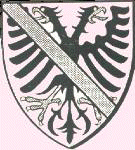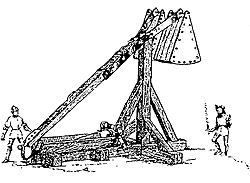

Eymet's History
Accueil
Eymet
Services
Tourisme
Vie économique
Canton d'Eymet


|
Eymet's History |
Accueil
|

Although the Bastide of Eymet was founded in the 13th century, around 700 years ago, human occupation of the site goes back thousands of years.

In the locality of "La Brande", only 1500 metres away, tools dating from all the prehistoric periods have been found. Jewels and domestic utensils made at the dawn of our era, and exhibited here in the chateau Museum, prove that this place was inhabited during the Bronze Age. The dolmen of Eylias and the sites of standing stones, the "Peyrelevades", prove the existence of a Gallic cult, a "nemet", which is probably at the origin of the town's name.
Then came the Roman occupation and the birth of Gallo-Romanic civilisation. In Eymet itself and in the surrounding countryside, the remains of many important Roman villas have been found near the villages of Serres, Sainte-Eulalie and Sainte-Innocence, and are yet to be excavated.
The density of the population of this privileged site is not surprising: 1500 years ago, Sidoine Apollinaire, the Latin poet wrote: This entire valley is so full of vineyards flowered meadows, culltivated flelds, fruit tree plantations deliciously shaded by hedges, watered by springs crossed by streams, rich in harvests, that their owners seem to have had a vision of paradise ! "No documents have been found that tell the story of this place between the end of the Roman Empire and the formation of the Duchy of Aquitaine; a gap of 500 years. Certainly several invasions by the Vandals, the Visigoths, the Arabs occurred, and even the Vikings travelled up the rivers in their long boats. The only known remains of this period are several Merovingian jewels and stone coffins.
Around the year 1000 A.D history retakes its course with the creation on the banks of the river Dropt of a priory, an offshoot of the abbey of Moissac. Here, at the cross-roads of two Roman roads was built a feudal mound surrounded by wooden defensive fences, soon after replaced by a castrum, the basis of the fortified castle the remains of which can still be seen today.The official history of Eymet begins on the 28th of june 1270 with the creation of the bastide.
Its location at this time depended on its links with Marmande in the Agen region, property of the counts of Toulouse. Alphonse de Poitiers, brother of king Louis IX (Saint-Louis) had become count of Toulouse in 1249 at the death of his father-in-law Raymond VII, last head of a powerful dynasty of which the estates extended from the region of Marmande ail the way to the Rhône.At that time, Alphonse began the construction of several bastides, middle-ages new towns, which wouhl ensure the control of his new territory.
To the North of this fiefdom was Sainte-Foy, built in 1255, then Castillonnès in 1259, Villeréal in 1267, and finally Eymet in 1270, marking the border with Périgord.|
|
Contrary to what one might think, the bastides, were not originally fortified and some, like Miramont-de-Guyenne, never were. The majority were only surrounded by fortified walls at the end of the XIIIth or at the beginning of the XIVth centuries. The ramparts were built more to discourage bandits than to resist the assaults of organised armies equipped with engines of war such as the "Coulliard" or the "Truye" (described further on). |
The middle of the XIIIth century was a relatively calm and prosperous period, and the new towns allowed a farming population to grow rapidly. Around them were grouped shopkeepers and artisans creating a community with a self-sufficient economy.
To each head of family was given one "ayral", a rectangular piece of land of approximately 200 m². It was up to the new owners to build their houses and barns very quickly - in less than two years - otherwise they would be fined.The lines were traced by surveyers according to the rules of urbanism inspired by the Roman towns: the streets and the alleys crossed at right angles as far as the configuration of the land permitted, as in the case of Eymet. Bastides were an example of what we now call town planning.

Covering penal, civil and tax laws, the charter determined precisely each citizen 's rights and duties. It marked the start of communal freedom compared to the feudal system which existed before. The town was directed by consuls, an assembly which was the forerunner of the local Council.
The "Bayle", a sort of Mayor , represented the founder who received a substantial and regular income, thanks to the taxes established by the Charter.In 1271, since Alphonse de Poitiers died without descendants, the County of Toulouse and of Agen was returned to the crown of France according to the Meaux treaty of 1229.
| Therefore, hardly one year after its creation, Eymet became French. But not for long! 8 years later, following the Amiens treaty, the County of Agen was given to Edward I of England, and from 1279 it was the flag depicting the Leopards of the Plantagenets which flew from the tower - an occupation challenged by the Kings of France but which continued indirectly all through the XIVth century, the Bastide having been given over to the"de Pellegrue" family by the English Kings. |
|
During the 100 years war, from 1337 onwards, it changed hands several times, but was only held briefly by the partisans of the kings of France.
|
|
We can read in history about the battle of the 1st of September 1377 told by Froissart, the most important chronicler of the time: Bertrand du Guesclin who commanded the troops of the Duke of Anjou, brother of king Charles V, had just taken back from the English - 0nly very briefly - more than 100 defensives positions, town and castles in Aquitaine. He put Bergerac under siege although it was strongly fortified by the king's steward Thomas Feilton. To demolish the walls, he acquired, in the town of La Réole, an engine of war called "la truye", a sort of huge ram which was pushed, said Froissart, by more than 100 men. |
| Felton was captured along with the Lords of Duras, of Rauzan and of Montferrand, who were soon freed after payment of a ransom. The convoy began to leave but the ram became blocked at Eymet's southern cntrance gate which was too narrow and had to be partially demolished. This gate from then on was called "Gate of the Engine" and the street which leads to it is still called "Rue de l'Engin". |
|
The city walls, built around 1320, had four principal gates which were destroyed along with the ramparts in 1830, plus a smaller one called "le Portanel" over looking the Dropt and which exists today.
After the short stay of du Guesclin, on the death of Charles V in 1380, Eymet, together with the rest of the region, once again came under English influence: through the Pellegrue family, overlords of Eymet and Soumensac, and the Got family of Pope Clément V, the powerful castellans of Puyguilhem, all faithful allies of the Kings of England.There then began a period of great misery, the local lords started pillaging, the lords of Eymet, Bridoire and of Théobon, the clerk of Rouquette and Robert King, captain of Puyguiihem, became infamous for their abuse of power in Bergerac and in the valley of the Dordogne.
The exact date of the end of the English occupation of Eymet is not known, and the only sure historical landmark is the surrender, in June 1451, of Gilbert de Pellegrue to Charles VII, King of France during the first occupation of Bordeaux by the French, two years before the battle of Castillon 17th of July 1453, when the defeat of the "Anglo-Bordelais" troops officially marked the end of the 100 years war and of 300 years of English occupation of the Aquitaine.
Barely 80 years later, the region was being influenced by the new protestant religion. In 1535 a member of the Bordeaux Parliament wrote to Queen Catherine de Medicis: " In the information that we are sending to your Majesty, we find that Bragerac (Bergerac), Sainte-Foy and Eyrnet - and other places - are beginning to distance themselves from the word of God and the Church."
The Caumonts, at that Lime overlords of Eymet and Puyguilhem, had entered into the Reformed Church as did the Duras clan. François de Caumont and one of his sons were in fact massacred in Paris 24th of August 1572 on the fateful Saint-Barthélémy 's night.It is not surprising, therefore, that the Queen of Navarre, Jeanne d'Albret, and her son Henri of Navarre were able to find many friendly houses in the region while they were being hunted by Montluc, much feared head of the Catholic faction.
- In the years around 1570, either one or the other of those persons passed through Eymet, La Sauvetat, Lévignac and Sadillac - then important Protestant localities.From 1580 onwards, Henri, who had become the military chief of the Protestants, led his operations against the Royal troops from Nérac and Sainte-Foy, and therefore, passed through Eymet on many occasion
| It is after his decisive
victory at Coutras, in October 1587, that he wrote a long letter to his
mistress Diane d'Andouins, the beautiful Corisande, headed: Aymet, thé
15th March 1588, and which ended: "I send you one thousand million
kisses from Aymet".
Henri of Navarre was to become the most popular King of France one year later as Henri VI. .. |
|
|
|
His son and successor Louis XIII on the contrary, endeavoured to eliminate the Protestant religion from the region. Delayed in Eymet in mid-July 1621 by torrential rains while he was laying siege to the town of Tonneins, he gave orders for the protestant Church to be demolished, and that the ramparts of Puyguilhem's castle, property of the Caumont family, should be dismantled. |
The reformed Church had become deeply rooted because fifty years later, on the 19th September 1671, Louis XVI ordered the destruction of the Protestant Church which had subsequently been rebuilt.
It was an imperial order given by Napoléon I in 1804 which authorised the building of the present Protestant Church on the site of the previous one.
From then on the History of Eymet is part of the History of France.
Publication: Office de Tourisme du Pays d'EymetText: Bertrand Alessandri and Gérard
Lallemant Translation:
Clin Bond
Illustrations:
Renaud Beffeyte, Henri Decoster, D.R., Gérard Lallemant
----------------------------------------------------------
Histoire - Visite guidée d'Eymet - Sites à visite - Plan - Vallée du Dropt
----------------------------------------------------------